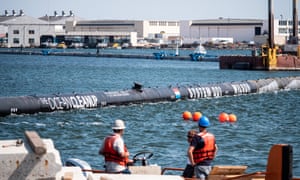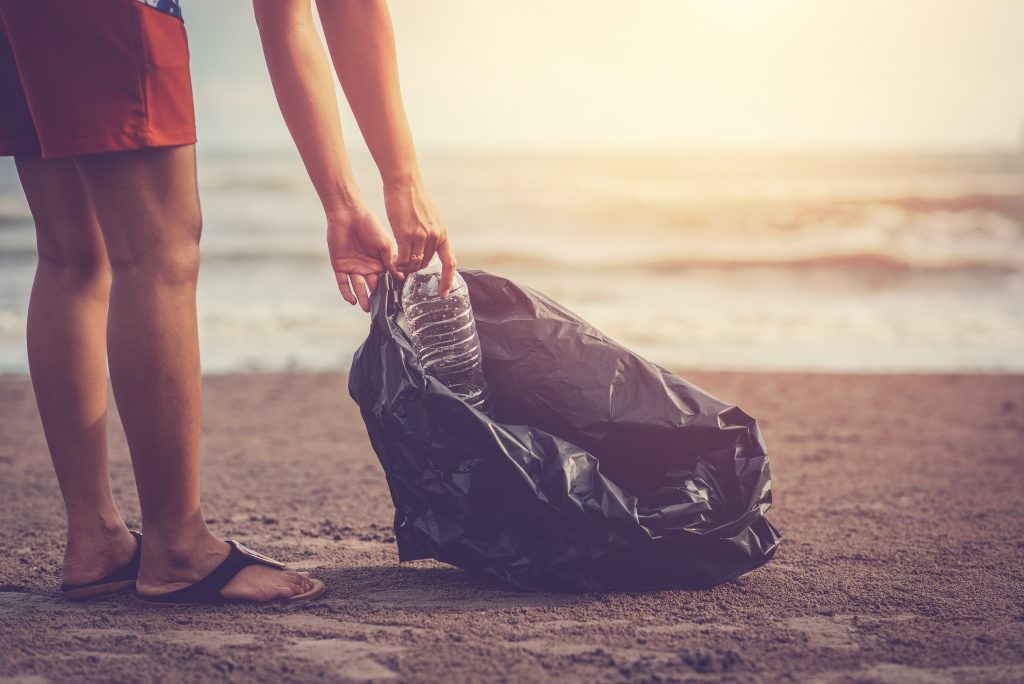Great Pacific Garbage Patch Clean-Up to Begin
A team of scientists and engineers will on Saturday begin an ambitious cleanup of plastics in the Pacific Ocean targeting a stretch of water three times the size of France known as the Great Pacific Garbage Patch.
A 600m-long floating barrier will be launched off the coast of San Francisco and, powered by currents, waves and wind, will aim to collect five tonnes of plastic debris each month.

The 600m-long floating barrier, known as System 001, will be launched off the coast of California. Photograph: System 001/Ocean Cleanup
The marine apparatus known as System 001 is the brainchild of the Dutch inventor Boyan Slat who founded The Ocean Cleanup at the age of 18 in 2013.
Along with 70 staff he has spent the last five years testing 273 models and six different prototypes as part of the $20m (£15.5m) Netherlands-based project before arriving at the current design – nicknamed “Wilson” in reference to the famous volleyball from the film Castaway.
The structure comprises 60 adjoining units forming a giant C-shaped tube attached to a three-metre deep impenetrable skirt which will collect plastic waste of 1cm diameter and larger, as well as discarded fishing nets, as it skims the ocean’s surface.
The cleanup system will be towed out past Alcatraz and beneath the Golden Gate Bridge into the Pacific Ocean where it will undergo two weeks of operational testing at around 250 nautical miles (463km) offshore before starting its mission. The system will be equipped with location-broadcasting technology in order to stop vessels from running into it.
The team expects to remove the accumulated debris every six weeks using a support vessel before transferring the plastic waste to the Netherlands to be recycled.
Oceanographer Laurent Lebreton explained: “Moving with wind and currents in the same way plastic does, the barrier should self-adjust once deployed. It will trap large debris before it can break down into harmful microplastics. Some 92% of plastic in the region is made up of pieces larger than 5mm so that is our focus.”
A recent study found 1.8tn pieces of plastic weighing 80,000 metric tonnes are currently afloat in the Great Pacific Garbage Patch – a stretch of ocean running between California and Hawaii covering 1.6m sq km.
It is the largest and dirtiest of five ocean circulatory systems known as gyres but researchers claim the project could remove 50% of plastics in the area within five years.
However, predictions that the Ocean Cleanup could remove 90% of surface plastics globally by 2040 using a full fleet of systems have been met with scepticism from environmentalists. Critics of the project also fear the system could pose a threat to marine life.
Rick Stafford, professor of marine biology and conservation at Bournemouth University, said: “It could remove a lot of large plastics from the ocean, which is positive as long as it will not harm sea life.”
The barrier was designed not to entangle fish and sea mammals which can swim under the skirt but Stafford said there would undoubtedly be a degree of bycatch.
“Fish such as tuna could get caught up in the debris. Or if turtles get pushed up into the skirt there is a chance they will end up eating the plastic.”
He also raised concerns about how the device might be cleaned and the possible use of toxic anti-fouling coatings that could leach into the sea.
But he added: “My biggest concern is that providing a potential technological solution could make us feel like we have dealt with the plastics problem – whereas in reality we need strong policy and legislation to ban disposable plastics.”
Sue Kinsey, pollution policy officer at the Marine Conservation Society, agreed.
“While we understand the desire and passion behind this project, we feel more time and energy must be invested to stop litter entering our oceans in the first place.
“Additionally we have serious concerns that wildlife will be affected, especially the smaller floating plankton that many creatures depend on for food and those organisms that float passively.
She added: “Litter is distributed throughout the water column and this device will only pick up the first few metres of material and miss much of the microscopic waste that is impossible to collect and recycle.”
The Ocean Cleanup published an independent environmental impact assessment in July to address such concerns.
Chief operating officer, Lonneke Holierhoek said: “Plankton and different types of marine life are already affected by the floating debris out there. We will work with the knowledge we gain to minimise any impact.”
She added: “We feel a sense of urgency to start cleaning up and to learn how our ideas will work in reality. But this is by no means the end of the process. We believe we can scale up pretty quickly and have a full fleet of systems in the north Pacific by 2021.”
A spokesperson for Greenpeace said: “Exploring new ideas and technologies to clean up ocean pollution is laudable and [the project] may even succeed in removing at least some of the waste. But prevention is far better than cure and in order to tackle the pollution crisis corporations must stop producing so much plastic.”

